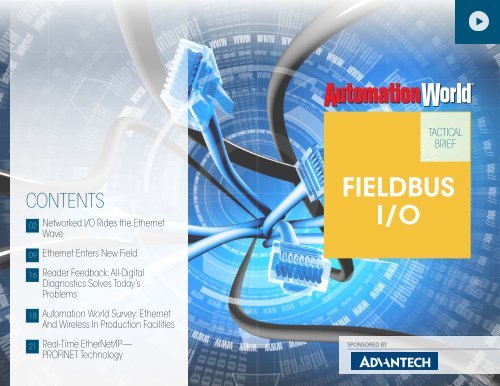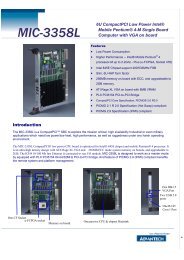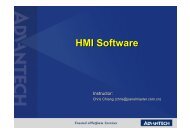FIELDBUS I/O - Advantech - Intelligent Automation
FIELDBUS I/O - Advantech - Intelligent Automation
FIELDBUS I/O - Advantech - Intelligent Automation
Create successful ePaper yourself
Turn your PDF publications into a flip-book with our unique Google optimized e-Paper software.
TACTICALBRIEFCONTENTS02Networked I/O Rides the EthernetWave<strong>FIELDBUS</strong>I/O09161821Ethernet Enters New FieldReader Feedback: All-DigitalDiagnostics Solves Today’sProblems<strong>Automation</strong> World Survey: EthernetAnd Wireless In Production FacilitiesReal-Time EtherNet/IP—PROFINET TechnologySPONSORED BY
NETWORKED I/ORIDES THE ETHERNET WAVETACTICAL BRIEF2/25Users are taking advantage of the different ways suppliers are exploiting Ethernet and the variouscommunications protocols available to distribute I/O devices.By James R. Koelsch, Contributing EditorThere may be more than one way to skin a cat, but thereis just one way of processing turkeys at the Cargill plantin Waco, Texas. And that way now relies on networkedinput-output (I/O) devices to oversee the ammonia-basedrefrigeration system at the heart of production. Like manyusers seeking to keep their processes as simple as possible,Minneapolis-based Cargill is linking the devices over anEthernet-based network.Keeping tabs on the refrigeration is crucial. “If the systemwere to go down, they would have to shut the plant down,”explains Barrett Davis, owner of Automate Co. LLC (www.automateco.com), a systems integrator based in Pacific, Mo.For this reason, Cargill asked Davis to upgrade the systemwith controls and I/O from Opto 22 (www.opto22.com), anautomation supplier based in Temecula, Calif.The upgrade at Cargill is indicative of a trend towardgreater proliferation of Ethernet in industrial automation.“The use of Ethernet as a physical layer has been thebiggest advancement in fieldbus I/O over the past decade,”observes Joey Stubbs, P.E., North American Representativefor the Nuremberg-based EtherCAT Technology Group(www.ethercat.org). He attributes the trend to the abilitySPONSORED BY
continuedNetworked I/O Rides the Ethernet WaveTACTICAL BRIEF3/25of the automation industry to industrialize consumer-drivencommodity products for fieldbus implementation, therebydriving development costs down.“In the past, the world’s fieldbus organizations had to createtheir own standards for everything from the connector to theprotocol to the stack,” Stubbs says. “Now, the physical layercan be handled by broader-based international standardsorganizations that drive these technologies for all areas ofuse—industrial, office, and consumer.”Consequently, networked I/O has continued to advance,resulting in better performance, flexible topology, andsimpler configuration. “With today’s networked I/O, systemupdates can be processed real-time in the sub-millisecondto microsecond range,” reports Kurt Wadowick, I/O productspecialist at Beckhoff <strong>Automation</strong> LLC (www.beckhoff.com/usa) in Burnsville, Minn. These higher processing speedscontinue to generate efficiencies in data collection andanalysis.Just as important has been the simultaneous evolutionof open communications protocols. “Ethernet’s physicalwiring combined with protocols such as EtherCAT, Profinet,EtherNet/IP, Powerlink and others were each originallydeveloped individually by controls manufacturers,” explainsWadowick. “They, however, have re-emerged as openstandards that can easily interface into other companies’devices, such as drives, encoders and various kinds ofindustrial controls on the I/O network.”As fieldbuses have become more open and dependentupon known physical technologies like Ethernet, I/O networkupdate rates have increased to the point where they can keeppace with real-time events in the control system. Anotherimportant advantage has been less copper. “In the goodold days, a great deal of wiring was required for industrialdevices, says Wadowick. Today, he says, connecting thesedevices to the controller requires only the I/O networkconnection, control power and, in the case of high-energydevices, three-phase power.SPONSORED BY
continuedNetworked I/O Rides the Ethernet WaveTACTICAL BRIEF4/25Simplicity with TCP/IPAt Automate Co., Davis specializes in the Opto 22 products because they usestandard transmission control protocol and Internet protocol (TCP/IP) on Ethernetbasednetworks. He likes the protocol’s simplicity. “It’s been well-thought-out fromthe get-go,” he says. “Serial has always been kind of a hassle to work with becauseyou can have mismatches between two systems from different manufacturers.”Although he acknowledges that you can always get serial networks to work, henotes that it usually requires a lot of effort.So, Davis usually argues for TCP/IP over some of the newer deterministicfieldbus networks wherever data collisions do not affect the reliability of TCP/IPcommunications in control applications. “These fieldbus solutions add complexityto Ethernet and TCP/IP,” he says. “They try to turn something nondeterministicby nature into a deterministic network. These attempts often over complicatethe entire process and make interoperability between different systems difficult.”It also drives up costs, because installing such things as IGMP (Internet groupmanagement protocol) snooping switches is necessary.Davis has found that the added complexity is unnecessary for most applicationsthat he typically sees. “UDP [user datagram protocol] packets go across thenetwork in a matter of a few microseconds,” he says. “Even if you get a collision,it has a whole scheme for handling that, and it retries very quickly.” Based on hisanalysis of Opto22’s hardware to respond, he is confident that he can configuremost proportional-integral-derivative (PID) loops to scan rates of less than fivemilliseconds.»Highly Flexible Remote I/OSolution to Extend Existing PLC I/O»<strong>Advantech</strong>'s APAX-5070 series ofRemote I/O products are designedwith high density I/O points for,flexibility, scalability, and hotswappablefunctionality as wellas a variety of I/O selections. Byhaving three protocol options:Modbus/TCP, PROFINET andEtherNet/IP, you can build a remoteI/O system to fulfill the remote I/Oneeds of exisiting PLCs or othercontrollers.LEARN MORE »SPONSORED BY
continuedNetworked I/O Rides the Ethernet WaveTACTICAL BRIEF5/25Although Davis believes that TCP/IP communications arefast enough for many I/O networks, an important exception ismachinery requiring sub-millisecond timing. For now, most ofthese applications will rely on specialty bus networks, he says.Delivers flexibilityBuilders of industrial automation for heavy manufacturingindustries like automotive are also seeing the benefits ofnetworked I/O. Not only must the automated machinerythere coordinate the motion of its own components, but itoften must also synchronize its tasks with other equipmentand people. And these lines must have the flexibility toaccommodate a mix of products and design changes.An example is vehicle production. “With high productionrates and a wide variety of model mixes within today’sautomotive factories, manufacturing systems are becomingmuch more complex,” says Andy Jones, global segmentdirector for commercial vehicles for Comau—AdaptiveSolutions of Southfield, Mich. “Even within commercialvehiclemanufacturing facilities, where the production ratescan be more than 10 times lower than the typical passengervehicle factory, networked I/O is still extremely important.”Simplicity is also important to this business unit of ComauS.p.A., the Turin-based builder of assembly lines for a varietyof industries. One reason is that the business unit servesindustries, such as commercial vehicle manufacturing, thatare relatively new to complex automation. Another reason istime to market. The time for bringing a vehicle from conceptto market is as crucial to market share in commercial vehiclesas it is for passenger vehicles.A flexible and robust communications architecture,therefore, is very important for eliminating costly delays indesigning, integrating and delivering the automation builtby Comau’s Adaptive Solutions business. “Our customersexpect reliable, cost-effective systems with the flexibility ofchanging to alternate component suppliers when necessary,”says Jones.Although the existing infrastructure—as well as the needsand abilities of the user—will dictate the networking schemeSPONSORED BY
TACTICAL BRIEF6/25continuedNetworked I/O Rides the Ethernet Wavechosen in the end, Camau engineers often specify EtherNet/IP,a standard protocol promulgated by ODVA (www.odva.org),with products from Milwaukee-based Rockwell <strong>Automation</strong>(www.rockwellautomation.com) and others.The EtherNet/IP protocol “enables all network devices tospeak the same language, making network communicationsmuch more robust,” says Jones. This ability allows puttinga variety of floor-level components, as well as integratedtechnology, including motion control, on the same network.Right now, Comau is looking into using EtherNet/IP forchanging the tools used by its robotic technology. “Automatictool-changing is very common in our assembly systems, inorder to make best use of the robots, precious floor space,and available cycle time by performing multiple operationswithin the same workspace,” explains Jones. Because quickconnecttechnology has not always been available for makingthese changes, the automation builder’s engineers would oftenhave to design solutions that required communicating overDeviceNet, which added an extra protocol. Putting the robotson the EtherNet/IP network should eliminate this complication.
continuedNetworked I/O Rides the Ethernet WaveTACTICAL BRIEF7/25Another important feature of EtherNet/IP is that itsupports the development of modular solutions that can beused again and adapted for future projects. Not only doesreusing previously proven modules save time in design andcommissioning, but it also streamlines equipment validation.On the Safety SideNetworked I/O can be an improvement over safety relays aswell, as the Lawrence Berkeley National Laboratory (LBNL)learned in Berkeley, Calif. The lesson came when it builtBella, the world’s most powerful laser, a petawatt laser thatgenerates pulses that last for 40 fetoseconds. To protectworkers and visitors from harmful radiation and exposure tolaser light, LBNL installed safety system with a distributedI/O and human-machine-interface (HMI) architecture.Bella occupies four moderate-sized rooms. The safety systemmonitors the 14 access doors and the shutters covering thelarge picture windows that observers use to view the laser.Some of the doors prohibit access to hazardous areas whilethe laser is on. If, however, other doors or the shutters areopen, the programmable logic controller (PLC) will safely shutthe laser down by taking control of the 18 shutters, three laserbeam dumps, and 17 power-supply circuits.“It wasn’t possible to do this project with safety relays.There is just way too much I/O for a programmable safetyrelay,” notes David Di Giorgio, lead engineer for the projectto design and install the laser’s safety system. Di Giorgio isdirector of computer engineering at Deterministic SystemsInc. (DSi) (www.dsicontrols.net), a controls engineeringcompany in Walnut Creek, Calif.The heart of the system is an S7-319F safety PLC, thefastest model made by Siemens Industry Inc. (www.usa.siemens.com/industry) of Alpharetta, Ga. Using ProfiSafeopen communications, an Ethernet-based ProfitNet networklinks the PLC to four remote safety I/O racks and four HMIs,one each for each room. Distributing the racks to the roomssimplified installation. “The cabinet would have been quitelong if we would have wired them all to one rack,” observesDi Giorgio. “Then, we would have had to figure out how toroute all these cables and pay for all the copper.”SPONSORED BY
continuedNetworked I/O Rides the Ethernet WaveTACTICAL BRIEF8/25»Flexible Remote I/O toExpand Control SystemsThe ability to send safety information and control “from one room to anotherusing only Ethernet and a set of power wires made the design clean and easilymodifiable during the design phase,” Di Giorgio adds. “In the future, this will alsoallow LBNL to modify the system as the needs of the experiments change.”DSi engineers got an idea of just how flexible the system is near the end ofthe project, during the final checking phase. The inspection uncovered that agroup of four alarms failed to turn off a device as they should have. Rectifyingthis oversight was a matter of changing one instruction because the alarms werealready grouped. Di Giogrio reports that actually reconfiguring the instructionsand compiling and downloading the change took roughly 15 minutes, but that thewhole event took about an hour when you include the discussions surrounding it.Besides this ability to make changes on the fly, another benefit of the distributedI/O architecture is that it assists troubleshooting. “When you’re troubleshootinga problem, it is more convenient to have the rack in the same room,” notes DiGiorgio. More importantly, the network offers more diagnostics than relays do.Although relay-based systems can offer redundancy, they cannot detect a shortcircuit to a sensor coming from another system. Failsafe inputs and outputs onthe safety PLCs, on the other hand, can detect short circuits.'»<strong>Advantech</strong>'s ADAM-6100 EtherNet/IP and PROFINET Series can build areal-time distributed control systemthat is reliant on reliable and realtimecommunication among thecontrollers and devices. Improvingsafety, quality, and efficiency, areal-time system is expected torespond not just quickly, but alsowithin a predictable period of timevia industrial-grade EtherNet/IP andPROFINET protocols.LEARN MORE »SPONSORED BY
ETHERNETENTERS NEW FIELDTACTICAL BRIEF9/25The ubiquitous office networking standard rapidly displacing proprietary fieldbus for input/outputcommunications.By Terry Costlow, Contributing WriterAn aging fieldbus system was causing too muchaggravation for engineers and technicians at RadiatorSpecialty Co.’s Charlotte, N.C., factory. A palletizingsystem for containers of Gunk, Liquid Wrench and otherproducts was often stopped when a fault on one nodebrought the whole system down.Networking glitches became so common that technicianscreated a workaround so that many of the workers on theplant floor could restart the network.“We put a power switchon the system so equipment operators could reboot whenwe weren’t around,” says Shawn LaHart, control technicianat Radiator Specialty. That reduced the pain and saved time,but production still remained at a halt for a couple of minuteswhile the system rebooted.Late last year, the company installed an Ethernet-compatiblefield bus, bringing the office networking standard used inSPONSORED BY
continuedEthernet Enters New FieldTACTICAL BRIEF10/25the factory down to the input/output (I/O) level. Now thatRadiator Speciality has deployed Beckhoff <strong>Automation</strong>’sEtherCat protocol, the emergency power switch is gettingdusty.“Our EtherCat system’s been running for monthswithout any errors,” says Project Engineer Murray Williamson.Radiator Specialty is one of many manufacturing companiestaking Ethernet down to the fieldbus level, making the ubiquitousnetwork look like the winner of the fieldbus wars of the mid-1990s. It’s even being used to tackle real-time problems, asmany vendors provide variations that provide determinism.Analysts note that adoption is still low compared to thefieldbuses that have been used for years.“There are stillmore nodes of all other fieldbuses than of Ethernet, but it’sdefinitely growing pretty rapidly,” says Harry Forbes, senioranalyst at ARC Advisory Group Inc., in Dedham, Mass. Henotes that in 2004, there were fewer than 1 million Ethernetnodes at the fieldbus level.However, there are a number of reasons that Ethernet’sgrowth in this role is expanding. Among them is that oncestandard Ethernet cabling—called “Cat 5” in the industry—is installed, companies are no longer tied to a fieldbus.Ethernet gives manufacturers an open environment, lettingthem use hardware and software from various vendors. Formany engineers, that’s cause for celebration.“Ethernet as a fieldbus has a ton of advantages,” says RyanBecker, senior programmer analyst at Brown Printing Co.,which prints many national magazines at its Waseca, Minn.,headquarters. Brown is now using modules from Opto 22, ofTemecula, Calif., to connect to I/O points.Becker notes that with older fieldbuses, it is difficult toextract data for production reporting, and it’s expensive to usetheir specific middleware to tie into I/O points. Now, he usesJava, C or Visual Basic programming languages to accessnodes. “With Ethernet I/O, I can communicate directly to I/Opoints at no added cost, and I can use any language I chooseto tie into I/O points and extract data,” he adds.Vendors note that the broad support for Ethernet makes itmuch simpler to do many common jobs. Ethernet connectionsSPONSORED BY
continuedEthernet Enters New FieldTACTICAL BRIEF11/25Easily Add I/O where Ethernet» Infrastructure Is Presentand compatible software are on personal computers (PCs), and there are anumber of off-the-shelf programs for many common tasks.“Now it’s relatively easyto develop and monitor software.Every laptop has Ethernet, so you can use a Web browser as a debugging tool.There’s nothing else to buy,” says Helge Hornis, intelligent systems manager atPepperl+Fuchs, a network component supplier based in Twinsburg, Ohio.» <strong>Advantech</strong>'s ADAM-6000 seriesaccomplishes the integrationof automation and enterprisesystems easily through internettechnology, so that users can avoidchanging the entire architectureof the control system and evenremotely monitor the device statusmore flexibly. <strong>Advantech</strong>'s ADAM-6000 modules are empowered bypeer-to-peer (P2P) and GraphicCondition Logic (GCL), and canperform as standalone productsfor measurement, control andautomation.LEARN MORE »SPONSORED BYAnother benefit is that regardless of which communication protocols aredeployed, data can be transferred freely throughout the network. That meansmaintaining these systems can be handled efficiently even from remote locations.“Now I can monitor the whole system from my desk, I don’t have to go onto thefloor and plug into a system,” says Williamson, of Radiator Speciality. He addsthat he can also log in from home or from an off-site meeting.Finding people who can do this debugging and other work is also muchsimpler.“The knowledge base for Ethernet is far higher than for any fieldbus,” saysBenson Hougland, marketing vice president at Opto 22. This experience makesit possible to set up a fieldbus in fairly short time.The PC world’s push towardsplug-and-play has made a networking technician’s job relatively simple.“Reconfiguring the system was mostly copying and pasting. I had the wholething done in a day,” says Radiator Speciality’s LaHart.That installation haseliminated delays from oft-occurring shutdowns, which provides a payoff thatRadiator Specialty management understands and appreciates. “An hour to us is a
continuedEthernet Enters New FieldTACTICAL BRIEF12/25few thousand dollars, so we’re probably looking at a few tensof thousands of dollars in extra throughput,”Williamson says.REAL TIMEMany users have been gaining the benefits of Ethernet fieldbuses since roughly the start of this decade. But in applicationsthat needed determinism, conventional fieldbuses have beenthe only option. However, that’s changing quickly.“There arealready a number of protocols for I/O tasks that aren’t timecritical. Now there are companies coming out with the speedthat’s needed for determinism,” says Todd Walter, a groupmanager at National Instruments Corp. (NI), an Austin, Texas,automation products vendor.A handful of networking companies are now providingvariations of industrial-grade Ethernet technologies thatprovide realtime capabilities, going into the low millisecondsand even low microsecond times needed to assure timelydelivery of message packets. This determinism now comesin many flavors. Among the available technologies areEtherCat, EtherNet/IP, Ethernet- Powerlink, the FieldbusFoundation’s High Speed Ethernet, Modbus TCP/IP,Profinet, and SERCOS III.Vendors note that the speed of these networks makesit possible to continue the broad thrust to integrate morefunctions into a single controller. Even in complex anddemanding applications such as motion control, it is nowpossible to handle many modules from a central controlpanel.“Synchronizing 100 servo axes in a microsecond issomething that’s never been done before,” says Skip Hansen,I/O systems product manager at Beckhoff <strong>Automation</strong> LLC,of Burnsville, Minn. Beckhoff developed EtherCat, whichis now an International Electrotechnical Commission (IEC)specification.Hansen notes that the bandwidth of real-time Ethernet givessystem integrators the ability to consolidate many jobs, or toalter the way they link equipment together. “Engineers haveto think differently to gain the full benefit of the technology,”he continues.SPONSORED BY
continuedEthernet Enters New FieldTACTICAL BRIEF13/25The capabilities of the network also make it possible tolink modules located at fairly long distances. Beckhoff istouting an approach that eliminates the delays of very longcable runs. It’s no longer necessary to be close to get realtimeperformance. “We can synchronize I/O down to thenanosecond level, providing deterministic I/O regardless ofwire length,” Hansen says.If membership in technical groups is any measure, interestin real-time Ethernet is high throughout the industry. FieldbusFoundation has more than 300 members and the EtherCatTechnology Group has more than 200.All this attention to high-speed Ethernet moves the fieldbuswars to another level, looking at applications and protocolsrather than all-encompassing proprietary architectures. Butthe competitive markets of this era make it likely that thisfieldbus war won’t last nearly as long as the battles thatbegan in the ‘90s. Most vendors don’t have the wherewithalto provide equal levels of technical aid for multiple solutionsto one problem.“We can’t provide the same level of supportfor each bus, so we’re spending a lot of time evaluatingwhich one will be our select bus,” says Brian MacCleery,group manager for NI’s Industrial Control and MeasurementGroup.ARC’s Forbes notes that these varied solutions are “apoint of confusion,” but that the diversity isn’t likely to have amajor impact on market growth. The various guises of realtimeEthernet are linked to vendors, so many users will likelyfollow the lead of their key vendors.However, the incompatibilities will show up when differentvendors’ equipment must communicate. While this will bean annoying issue for many plant managers, it will be evenmore vexing for the system integrators who help them getplants functioning efficiently. For these companies, andforequipment suppliers who must work in heterogeneousapplications, it often won’t be possible to pick only one.The vendors promoting these disparate architectures wantto provide differentiation, so they have little incentive to worktoward finding a single solution. But most observers feel thefield will narrow over time. “Eventually, this will resolve downSPONSORED BY
TACTICAL BRIEF14/25continuedEthernet Enters New Fieldto one or two leading architectures. The networks won’t allgrow at the same rate, so the market will decide how manyand which ones survive,” Forbes predicts.Though there is significant momentum behind the expansionof Ethernet usage, observers note that the Institute of Electricaland Electronics Engineers (IEEE) standard isn’t the ultimatesolution for current problems. In many applications, there’sstill some need for a hierarchy of networks.“There’s still cost associated with Ethernet switchesfor each device that needs a switch,” says Jim Remski,automotive powertrain business manager for Siemens Energy& <strong>Automation</strong>’s Automotive Business Unit, in Alpharetta,Ga. He points out that existing fieldbus switches are oftenembedded into equipment.Remski also notes that lower-level buses that handle smallamounts of data from sensors and other devices with minimalintelligence are sometimes the best solution. That sentimentis echoed by others.
continuedEthernet Enters New FieldTACTICAL BRIEF15/25“We don’t condone using Ethernet for everything. CAN(Controller Area Network) is good for products with smallpieces of data like sensors,” says Hougland, of Opto 22.ARC’s Forbes notes that simple products such as proximityswitches that don’t have diagnostics are another applicationwhere Ethernet may be too costly.Another potential reason for avoiding Ethernet is its opennessto viruses and hacker attacks. But for the most part, that’s ahigher-level issue that doesn’t go down to the fieldbus level.That’s because it is not generally desirable to have equipmenton a fieldbus communicating freely with any other device onthe network. “You can configure the I/O so it only listens tocommunications from defined addresses,” Hougland says.Though there are solid reasons for not using Etherneteverywhere today, that may not remain the case. Someobservers feel that the semiconductor industry’s continuingdrive to integrate more peripherals onto chips that costless may eventually make Ethernet suitable in thoselow-performance applications. “When you can buy amicrocontroller that has everything for under $5, Ethernetbecomes basically free,” says NI’s Walters.The low cost of microcontrollers is already making it easyfor design engineers to include Ethernet on a growingnumber of products that tie into fieldbuses. As with manyelectronic technologies, once a couple of high end productsincorporate a feature or function, it rapidly becomes acommon attribute on many of the emerging new products.“Many motor controllers have Ethernet now; they didn’t acouple years ago,” Hougland says.'SPONSORED BY
READER FEEDBACK:ALL-DIGITAL DIAGNOSTICSSOLVES TODAY’S PROBLEMSTACTICAL BRIEF16/25Letter to the Editor Re: Field Device Diagnostics: Desire and Reality, AW September 2012By Larry O’Brien, global marketing manager with Fieldbus FoundationIread with interest the article by Peter Ebert on fielddiagnostics. To me and to many of us that deal with fieldbustechnology on a regular basis, the diagnostics issue is reallyan information management problem that can be solved withthe technology we have today, and there are key differencesin how Foundation fieldbus handles diagnostics versus HARTand other protocols.Let’s start with NAMUR NE 107, which the Fieldbus Foundationhas incorporated into our specification. NE 107 diagnostics havebeen part of our specification since 2010. Our Field Diagnosticsspecification was developed in close collaboration with NAMUR[a German process industry user organization]. Many of therequirements outlined in the NAMUR recommendations, suchas support of alarms, were already included in the specification.In fact, all new devices that will be registered from this pointon with Version 6 of our Interoperability Test Kit (ITK) mustsupport NAMUR NE 107 graphics and diagnostic managementcapabilities. All of our host systems tested through our HostProfile Testing and Registration program must also conform—that’s especially applicable to our integrated DCS hosts. We arecurrently the only organization with this mandatory requirementfor NAMUR NE 107 support for testing and registration ofdevices and hosts.NAMUR NE 107 is extremely valuable because it not onlycreates standard symbols and terms for reporting diagnosticconditions, it makes it a lot easier to classify diagnostics interms of severity and root cause (i.e. is it a process problem? Asensor problem? An electronics problem?)SPONSORED BY
continuedReader Feedback: All-Digital Diagnostics Solves Today’s ProblemsTACTICAL BRIEF17/25»A Small Devicefor Big ApplicationsYes, both HART and Foundation fieldbus and lots of other protocols offer diagnosticinformation. However, when you go completely digital as you do with Foundationfieldbus, the volume and type of diagnostics that are available to you increaseexponentially, as does the bandwidth to report these diagnostic conditions (all-digital,so you can transmit multiple process variables and diagnostic conditions across thenetwork).»With over 1 million modules sold,<strong>Advantech</strong>'s ADAM family is oneof the most compact and flexibleremote I/O modules on the market.Despite being virtually hidden fromview, they serve an important roleas a gateway to every imaginabledevice that does sensing or control.Watch this video to learn more.WATCH VIDEO »SPONSORED BYThe Foundation publish/subscribe architecture also means that diagnosticinformation is continuously pushed to the people that need it, when they need it, withno delay and no requirement for polling devices. All of a sudden you find yourself ableto access thousands of diagnostic parameters at a time from many different devicesacross your fieldbus network. It’s like seeing television in high definition for the firsttime, and it goes way beyond the ability to detect a plugged impulse line.You need a common sense way to manage the information you are getting so thatit is actionable, and people only get the right information to the right people at theright time. That’s the real beauty of NAMUR NE 107 and why our end user clientsdecided it was time to make these recommendations part of the Foundation fieldbusspecification. Because we are an open standard guided by our end user council, wecan make additions and improvements to the specification as they are required.The all-digital nature of our diagnostic capabilities also allow users take the wholediagnostics platform up a level, by looking at interrelationships between diagnosticconditions on different devices across the unit or the plant to create diagnostic profilesof the process itself and even plant equipment. This takes diagnostics into a wholenew dimension, where it becomes part of your overall plant optimization strategy. '
AUTOMATION WORLD SURVEY:ETHERNET AND WIRELESS INPRODUCTION FACILITIESTACTICAL BRIEF18/25An exclusive <strong>Automation</strong> World survey looks at current engineering and management opinionssurrounding the use of Ethernet and wireless networks across industry.By David Greenfield, Media & Events Director, <strong>Automation</strong> WorldTen years ago it was difficult to find large numbers ofengineers open to the idea of using Ethernet for plantfloor operations. As for their opinion on wireless… forgetabout it. If Ethernet was a stretch for most engineers due toits perception as an IT network for front office operations, theuse of wireless (outside of remote, long distance processoperations) was just crazy talk.But in the last few years, a noticeable shift has takenplace in operations engineers’ attitudes about Ethernetand wireless network technologies. We first started seeingdemonstrable proof of this in the <strong>Automation</strong> World Innovationsurvey conducted in late 2011. In that survey, nearly half ofrespondents said the incorporation of Ethernet into plantfloor systems was the most innovative advance to occur inautomation over the past decade. With so many readers citingthis development as being more innovative than any other,Ethernet’s advance onto the plant floor was recognized as theclear innovation winner in readers’ opinions.With this new <strong>Automation</strong> World survey, sponsored by Moxa(www.moxa.com), we wanted to dig deeper and learn not justwhat engineers think about Ethernet and wireless in the plant,but how they are using it there and what their plans are forit. Nearly one thousand readers from a variety of industries—ranging from automotive, chemicals, and electronics to food& beverage, oil & gas, and machinery/equipment OEMs —responded to the survey. Here’s what we learned.SPONSORED BY
TACTICAL BRIEF19/25continued<strong>Automation</strong> World Survey:Ethernet And Wireless In Production FacilitiesAre Plant Managers andEngineers Open to Using Ethernet?With only 7 percent of plant managers and engineers nowopposed to the idea of Ethernet in the plant, the number ofnaysayers that could block adoption of this technology hasshrunk considerably over the years. Ethernet is a ruggedand versatile technology, and multiple robust and high-speedprotocols are available. Research shows users in all industriesare investing in Ethernet technologies.Where Respondents Use EthernetOne result that speaks to the overwhelming acceptance ofEthernet in the plant is the fact that Ethernet is used at themachine level to connect devices and instrumentation (74percent) nearly as often as it is used to connect front officedevice communications (77 percent). Given that an initial useof Ethernet in the plant was to connect production systems tothe enterprise, a surprisingly lower number of respondents (56percent) currently use Ethernet to connect shop floor systemsto the enterprise than use the technology to connect devicesat the machine level.
continued<strong>Automation</strong> World Survey:Ethernet And Wireless In Production FacilitiesTACTICAL BRIEF20/25Current Status of Ethernet AdoptionThough a number of respondents are just now beginning to useEthernet on the plant floor, a significant number (41 percent)has been doing it for years and is thinking about additionalapplications for it. The fact that nearly as many respondents(22 percent) have connected everything possible on the plantfloor with Ethernet as are just beginning the process (26percent) really speaks to how widely Ethernet is accepted asa factory floor network compared to prevalent opinions just adecade ago. The number of respondents beginning to explorewireless (12 percent) may seem low, but in many factoryinstallations high levels of electromagnetic interference cancause problems for wireless networks. New products (suchas wireless/cellular hybrid technologies) are now comingto market to address these issues and will likely cause thispercentage to surge in the years ahead.Installation and Maintenanceof the Current Ethernet NetworkDespite the fact that tensions between IT and productionengineers still persist in many companies, Ethernet may wellprove to be the technology that helps lead these two groupsto develop a better perspective of one another. When itcomes to Ethernet installation and maintenance responsibility,the approaches are evenly split: Roughly one-third say theIT department handles it, and another one-third give theresponsibility to staff engineers. The remainder outsourceresponsibility to systems integrators or equipment suppliersvia service contracts.How Ethernet Use on the Plant Flooris Expected to Change in the Next 5 YearsBeyond the top responses about expected changes forEthernet on the plant floor, a separate open-ended questionrevealed other specific ways users want to use Ethernet.These include: remote switching of power distributionnetworks; more use of Power over Ethernet; real-timeinstrument data feeds over Ethernet; converting processcontrol operator stations to Ethernet; connecting dedicatedsafety controllers with Ethernet; connecting servo drives withEthernet; implementing IEEE 1588 precision time control;connecting work cells and machines to form a SCADA/MESsystem; and connecting to factory floor machines with asmart phone.'SPONSORED BY
REAL-TIME ETHERNET/IP—PROFINET TECHNOLOGYSPONSORED CONTENTTACTICAL BRIEF21/25Twenty years ago, there were competing networkprotocols in the enterprise (office) network space.Today, no one would believe that, because there is onlyone network protocol that is used in 99%-plus of all enterprisenetworks. That network is Ethernet running TCP/IP.What is Ethernet?Ethernet is ubiquitous. Our computer networks all are runon Ethernet, even our video games and HD video devices inour homes are Ethernet enabled. So it is very important tounderstand what Ethernet is, how it works, and what it canand cannot do. This is especially important in the industrialenvironment, as Ethernet becomes common on the plant floor.Ethernet is a family of frame-based, or data packet based,networking technologies that are part of the IEEE 802.3standard. There are several varieties of Ethernet. Originallybased on a coaxial cable format, like the old analog cableTV cable, Ethernet cabling became based on twisted pairtechnology adapted from telephony (see Fig. 1), becausethis kind of cable was already run in many offices and wasunderstandable to most cable installers. Thus, 10Base-T wasdeveloped as a star topology, similar to telephony, and thiswas continued in 100Base-T and other higher throughputformats.Ethernet networks consist of nodes, switches, routers andrepeaters. Switches, especially smart managed switches,have made it possible to have Ethernet networks consisting ofa nearly infinite number of nodes.Ethernet nodes send each other data packets. As with otherIEEE 802 LANs, each Ethernet node is given a MAC (mediaaccess control) address. The MAC addresses are used tospecify both the destination and the source of each datapacket. All packets are broadcast, that is, they are sent toall nodes. Data in the packet causes the node for which thepacket is intended to wake up and grab the data. Adapterscome programmed with a globally unique address. Nearly allgenerations of Ethernet use the same frame formats and canbe readily interconnected using bridges.
continuedReal-Time EtherNet/IP—PROFINET TechnologyTACTICAL BRIEF22/25SPONSORED CONTENTSpeed and DeterminismBut here’s the problem. Since Ethernet is broadcast, all ofthe packets go to all of the nodes. Managed switches, suchas the <strong>Advantech</strong> EKI-6558TI (shown in Figure 2), help bydirecting the data packet to only the designated receivingnode or nodes, but the fact remains that collisions betweendata packets are a serious problem. They can cause bothbandwidth reduction and data loss. This is manageable inthe enterprise (office) environment, but not so much in theindustrial plant environment.What happens is that data can take variable paths andtherefore variable times to travel from the sending node tothe receiving node. If this is an email, nobody cares—in factnobody notices. If this is a control variable for a high-speedCNC mill, packet loss and speed loss can be disastrous.The industrial environment requires “real-time” informationtransfer. Because the time it takes for any given packet toarrive at its destination on an Ethernet LAN is not determined,it is difficult to guarantee real-time control functions overEthernet. The time it takes for each packet to arrive at itsdestination should be determined…that is, the process mustbe deterministic.Determinism does not define speed. These are quitedifferent concepts. Here’s an example to help us understandthe difference between determinism and speed. If you live amile from work, and at 4 pm you tell your wife that you will behome in an hour, you’ve determined the time frame in which toconduct your trip home. Note that your speed will be about 1mile per hour. It doesn’t take much speed to accomplish thistiming goal. But things hold you up at work and you don’t gethome until 6 pm. What happened? Well, you told your wife,when you realized what time it was, you drove 100 miles anhour all the way home (one mile). It wasn’t an issue of speed;it was an issue of determinism. The desired effect was notaccomplished in the specified time frame.Generally, in the control world on the industrial plantfloor, speed and determinism are both needed. Speed isnecessary for the greatest possible throughput. Determinismis necessary to define a level of quality for the throughput; thatis, the highest speed throughput that is usable.Modbus and Modbus TCPOriginally, data transmission on the plant floor was done byproprietary twisted pair serial communications protocols (like
continuedReal-Time EtherNet/IP—PROFINET TechnologyTACTICAL BRIEF23/25SPONSORED CONTENTRS-232 and RS-485) which were deterministic by nature,since they were half-duplex. There was a defined amount oftime to wait for any response after sending any messagefrom the master. The timing was very predictable (hencedeterministic) but it was very slow.One of the first, if not the first, industrial data network wasModbus, a half-duplex serial protocol devised by Hung Yu in1979 for Modicon PLCs, hence the name MODiconBUS.Modbus, being half-duplex, is highly deterministic, but beingserial, is quite slow, with data transmission rates as rates asslow as 300 baud (typically 2.4Kbaud).The COTS RevolutionWith Ethernet, the rate of communication (the speed) is muchfaster, but the time span (the determinism) in which a responseis expected is unpredictable.Using Ethernet is also a gateway to the extremely largeand relatively inexpensive pool of COTS (commercial off theshelf) products that have been created for Ethernet and theenterprise environment. With many IT departments in controlof both plant and enterprise networking, there is significantpressure to use COTS network nodes and switches, even inthe environment of the factory floor. Ethernet is everywherealready, the argument goes, so let’s use it everywhere, evenwhere it isn’t the optimum solution.There have been many attempts to adapt Ethernet technologyto better serve the plant floor. There are, at last count, over 30protocols specifically designed for the industrial environment.Many of these are open, and standards-based, such asFoundation fieldbus, Modbus, DeviceNet and ControlNet (theCommon Industrial Protocols) and others.Three of these protocols have significant followings in bothdiscrete and process automation: EtherNet IP, Modbus, andProfibus and PROFINET.Ethernet/IP and The Common Industrial ProtocolsEtherNet/IP can easily be confused with Ethernet and IP, theInternet Protocol. EtherNet’s “IP” actually stands for “IndustrialProtocol.” EtherNet/IP is an industrial protocol that operatesover Ethernet, using the Common Industrial Protocols(ControlNet, DeviceNet). EtherNet/IP is an application-layerprotocol, and it considers all of the devices on a network to be
continuedReal-Time EtherNet/IP—PROFINET TechnologyTACTICAL BRIEF24/25SPONSORED CONTENTobjects. Here is where the confusion begins. EtherNet/IP isbuilt on the standard TCP/IP stack, making it easy to interfaceplant floor data from devices such as PLCs and PACs withenterprise servers running Ethernet TCP/IP. This also makestransmitting data over the Internet practical and even makesstorage in “cloud computing” servers possible.Although EtherNet/IP was developed by Rockwell <strong>Automation</strong>for its Allen-Bradley line of controls, it is now considered anopen standard, and is managed by ODVA (www.odva.org).Formerly known as the Open DeviceNet Vendors Association,ODVA now calls itself “the organization that supports networktechnologies built on the Common Industrial Protocol (CIP)— DeviceNet, EtherNet/IP, CompoNet, and ControlNet.”EtherNet/IP is designed for those control applications thatcan accommodate a measure of non-deterministic datatransfer, but it is significantly more robust and deterministicthan standard Ethernet and TCP/IP are.Profibus and ProfiNet TechnologyProfibus and PROFINET are also managed as open standardsby Profibus and PROFINET International (PI) even thoughthey were originally created by Siemens.Profibus is significantly more deterministic than EtherNet/IP,just as the other CIP protocols (DeviceNet and ControlNet)are. PROFINET is designed to be an industrial protocolrunning on Ethernet, similar to EtherNet/IP. Profibus andPROFINET are designed to work together, just asODVA has revised the CIP protocols to work together.There are millions of Profibus nodes installed in both discreteand process automation.According to Profibus/PROFINET International, PROFINETis an open Ethernet standard, designed to be “real-timeEthernet.” PROFINET has two models: the component modelor PROFINET CBA and the peripherals model, or PROFIBUSIO. The transmission times, however are different.Speed is everything. There are three different protocol levelsin PROFINET, and they are differentiated by speed.PROFINET CBA for a plant with reaction times in the rangeof 100ms uses TCP/IP.PROFINET CBA and IO applications up to 10ms cycletimes use the RT (Real-Time) protocol.
continuedReal-Time EtherNet/IP—PROFINET TechnologyTACTICAL BRIEF25/25SPONSORED CONTENTPROFINET IO applications in drive systems for motioncontrol use the IRT (Isochronous Real-Time) protocol for cycletimes of less than 1 ms.What EtherNe/IP and PROFINET have shown is thatdeterminism isn’t all or nothing. If you can legitimately expectto operate at speeds of less than 1 ms, the potential fordeterministic failure is extremely low. Especially if you’re reallyworking at 10 ms or 100 ms.What the Future HoldsWhile EtherNet/IP, ODVA and the Common IndustrialProtocols along with Profibus/PROFINET International areuseful and widely used relatively stable non-deterministicprotocols, each of the standards organizations’ objective is toprove themselves to be the highest speed solution. This, whilethey remain highly deterministic under the most rigorous useof the speed available.Each of the 30+ fieldbus protocols has advantages anddisadvantages. In many cases, the choice of fieldbus protocoldepends on the user’s choice of products and componentsfrom a vendor or vendors. Compatibility of the control devicemust also be considered. End users, machine builders andintegrators often select protocols based on the purchaser’scomfort level with the vendor, or a favored protocol type.Sometimes, users will select protocols and bus types basedon performance. If you need 1 ms speed, you will not choosea 250 ms response bus, regardless of how much you like theslower vendor.The battles over fieldbus protocols continue. There are noclear winners out of the 30-odd.The first protocol that can produce robust, fast anddeterministic control, all three, will win. Determinism is thelimiting factor to overcome.Unfortunately, the limiting component is, and will remain,Ethernet. As long as it is the protocol of choice in IT, and thecost of even industrially hardened Ethernet switches and I/Oare low, Ethernet will remain the communication protocol ofchoice. '
















